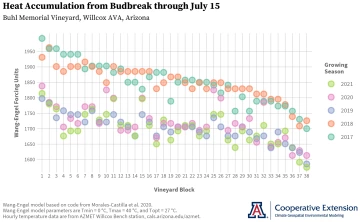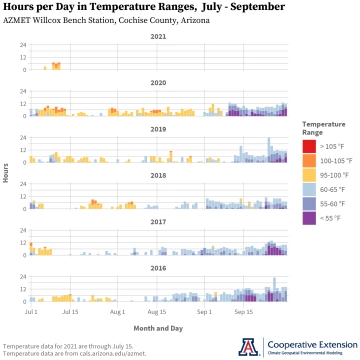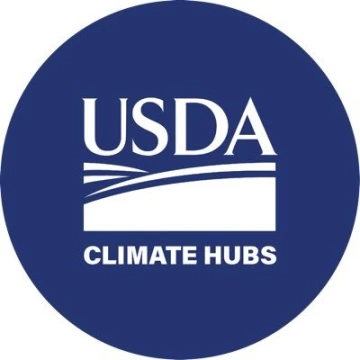< Back to Climate Viticulture Newsletter
Hello, everyone!
This is a July 2021 special issue of the Climate Viticulture Newsletter – a quick look at some timely climate topics relevant to winegrape growing in Arizona and New Mexico.
Heat Accumulation and Veraison
Temperatures over the past couple of weeks haven’t done much to change our assessment from the start of this month of how heat accumulation since budbreak might influence the timing of veraison. Based on the Wang-Engel model, which accounts for the slowing and eventual stopping of vine photosynthesis and growth as temperatures rise above 95 °F (35 °C), the start of the ripening period this year (green dots on graph) still looks to be similar to or slightly later than that of 2020 and 2019 (pink and blue dots, respectively). Lower forcing unit values from the Wang-Engel model suggest later veraison dates. With plainly higher values, veraison dates from 2018 and 2017 (orange and aqua dots, respectively) appear to be the earliest in recent years, at least at this location in the Willcox AVA.
We’ll check back in with this analog approach at the beginning of August. Please let us know how the timing of veraison is going in your vineyard this growing season relative to past ones. Information like this will be helpful as we work on calibrating this phenology model to local conditions and varieties. Our thanks once again to Jesse Noble at Merkin Vineyards for providing budbreak dates.

Jeremy Weiss
Temperature Ranges and the Ripening Period
Now that the ripening period has started or is near, we return to tracking hours of temperatures below 65 °F and above 95 °F. The reason why is that temperatures affect fruit quality through both early morning minimums and afternoon maximums as fruit ripens.
Sticking with temperature data from the AZMET Willcox Bench station that we used above, there have been just a few days since July 1 this year with temperatures above 95 °F (yellow and orange bars in top graph). This is less than what was measured in 2020 and more comparable to the 2016 through 2019 growing seasons. Temperatures have not yet dropped below 65 °F this month. Looking back at the previous five years, this doesn’t seem to be out of the ordinary as July hasn’t recently been a month during which we see a lot of hours below this threshold (light blue, dark blue, and purple bars).
As with the above analysis of heat accumulation and veraison, we’ll check back in with this topic at the beginning of August.

Jeremy Weiss
To stay informed of long-range temperature and precipitation possibilities beyond the coverage of a standard weather forecast, check in with the six-to-ten-day outlook and eight-to-fourteen-day outlook issued daily by NOAA’s Climate Prediction Center.
Undergraduate students in the College of Agriculture and Life Sciences at the University of Arizona are looking for internships with businesses and companies in the viticulture and winery industries during 2021. Please contact Danielle Buhrow, Senior Academic Advisor and Graduate Program Coordinator in the Department of Agricultural and Resource Economics, for more information.
A recent donation of 40 acres near Willcox plus recent funding from the USDA-AZDA Specialty Crop Block Grant program are some of the first steps of a newly formed public-private collaboration towards a Viticulture Center of Research (VCOR) that will help support winegrape growing in Arizona. The funding will provide resources to convene the state viticulture industry and its supporters in the latter half of 2021 to determine common interests and develop plans for moving the VCOR project forward. Another first step is to gather letters of support that demonstrate backing of the VCOR project from the Arizona viticulture industry to relevant leaders in the University of Arizona. To learn more about the VCOR project and how to contribute a letter of support, please contact Joshua Sherman, commercial horticulture agent with University of Arizona Cooperative Extension.
For those of you in southeastern Arizona, Cooperative Extension manages an email listserv in coordination with the Tucson forecast office of the National Weather Service to provide information in the days leading up to agriculturally important events, like days with severe monsoon storms or excessive heat. Please contact us if you'd like to sign up.
Please feel free to give us feedback on this issue of the Climate Viticulture Newsletter, suggestions on what to include more or less often, and ideas for new topics.
Did someone forward you this newsletter? Please contact us to subscribe.
Have a wonderful rest of July!
With support from:





